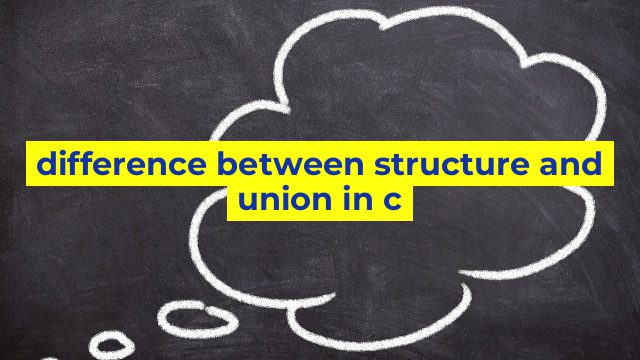Difference between structure and union in C
C language is a widely used programming language for developing computer applications. It provides various data structures to store and manage data efficiently. Two commonly used data structures in C language are structures and unions. Both structures and unions are used to define custom data types. However, they differ in their usage and functionality. In this article, we will discuss the difference between structure and union in C.
Structure in C
A structure is a user-defined data type in C that allows the programmer to group related data items of different data types into a single entity. In other words, a structure is a container that holds different data types under a single name. Each data item in a structure is called a member. The members of a structure are accessed using the dot(.) operator.
The syntax for defining a structure in C is as follows:
struct structure_name
{
data_type member_1;
data_type member_2;
…
data_type member_n;
};
For example, let’s define a structure named “employee” that contains the details of an employee such as name, age, salary, and department.
struct employee
{
char name[50];
int age;
float salary;
char department[50];
};
In the above example, the structure “employee” contains four members of different data types.
Union in C
A union is a user-defined data type in C that allows the programmer to store different data types in the same memory location. Unlike structures, unions can hold only one value at a time. Each member in a union refers to the same memory location, and the size of the union is equal to the size of its largest member.
The syntax for defining a union in C is as follows:
union union_name
{
data_type member_1;
data_type member_2;
…
data_type member_n;
};
For example, let’s define a union named “test” that contains three members of different data types such as int, char, and float.
union test
{
int a;
char b;
float c;
};
In the above example, the union “test” contains three members of different data types, but only one member can be used at a time.
Differences between structure and union in C
Here are some differences between structure and union in C:
1. Memory allocation: In a structure, each member is allocated a separate memory location based on its data type, whereas, in a union, all members share the same memory location.
2. Size of the data type: The size of a structure is the sum of the sizes of its members, whereas, in a union, the size of the union is equal to the size of its largest member.
3. Accessing members: The members of a structure are accessed using the dot(.) operator, whereas, in a union, all members refer to the same memory location.
4. Usage: Structures are mainly used to group related data items of different data types into a single entity, whereas unions are used to store different values of the same memory location.
5. Flexibility: Structures are more flexible than unions as they can store multiple values simultaneously, whereas unions can hold only one value at a time.
In conclusion, structures and unions are two important data structures in C language. Both structures and unions have their own advantages and disadvantages, and their usage depends on the requirements of the program. Knowing the difference between structure and union in C can help developers choose the appropriate data structure for their programs.
Table difference between structure and union in c
| Property | Structure | Union |
|---|---|---|
| Definition | A structure is a user-defined data type that groups related data members under a single name. | A union is a user-defined data type that allows the storage of different data types in the same memory location. |
| Memory allocation | Each data member of a structure is allocated a separate block of memory. | All data members of a union are allocated the same block of memory. |
| Memory usage | A structure uses more memory than a union because each data member is allocated with its own block of memory. | A union uses less memory than a structure because all data members share the same block of memory. |
| Data access | Each data member of a structure can be accessed independently using the dot operator. | Only one data member of a union can be accessed at a time because they all share the same memory location. |
| Data updating | Individual data members of a structure can be updated independently without affecting other members. | Updating one data member of a union will overwrite the value of all other members because they occupy the same memory location. |


